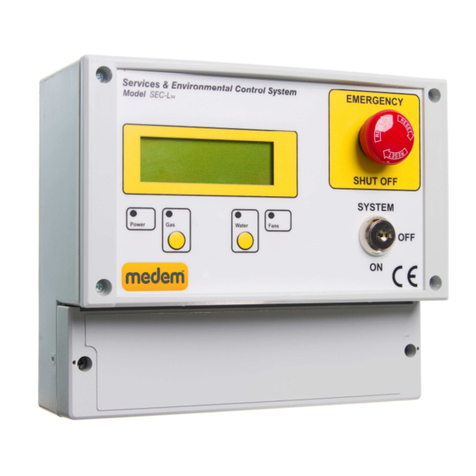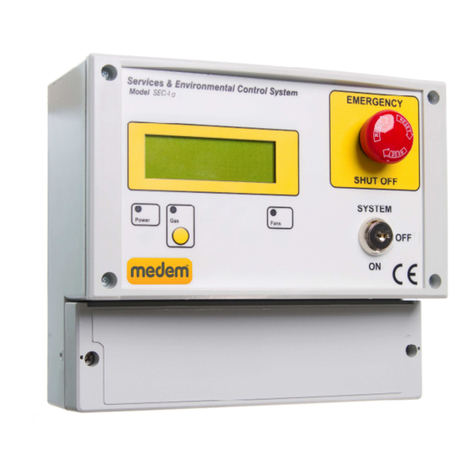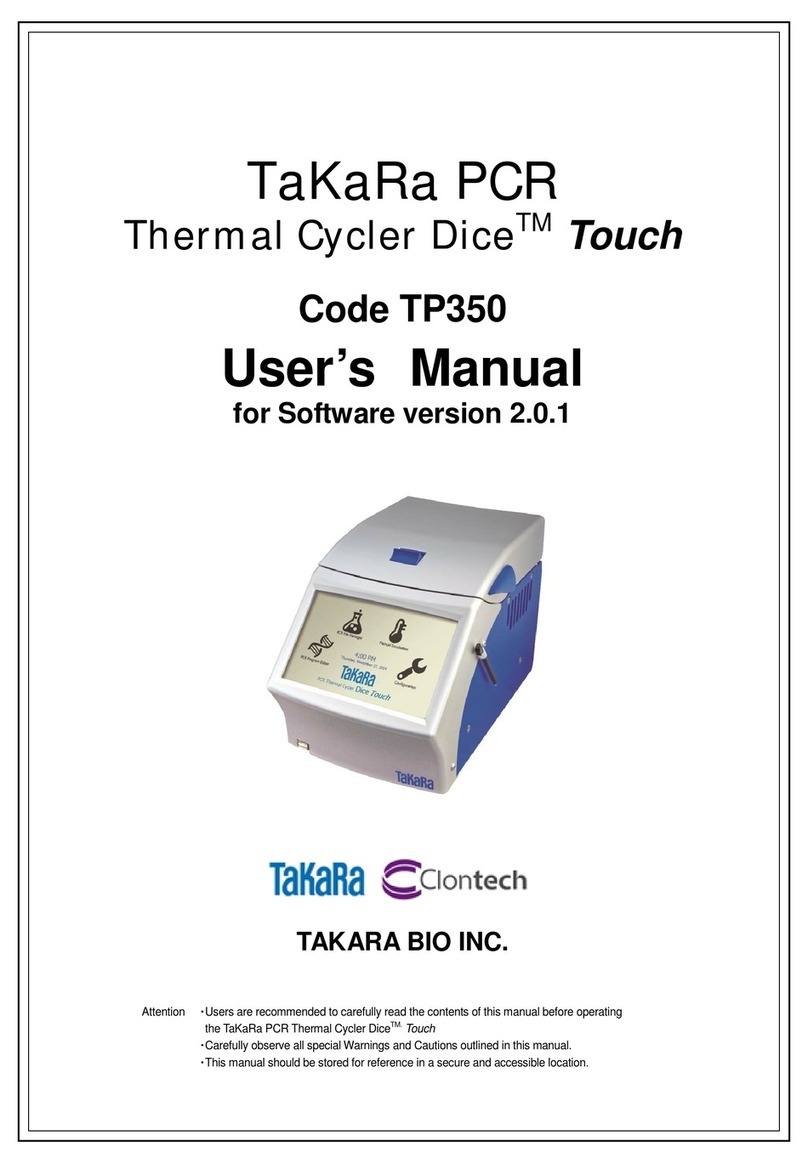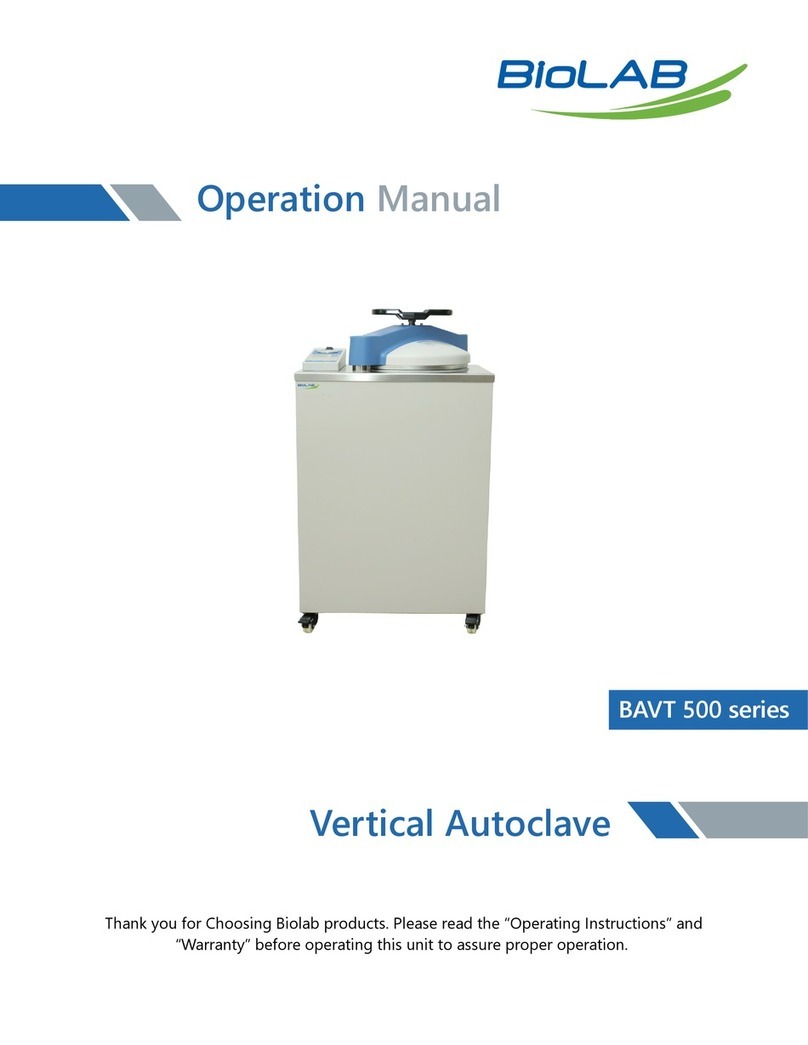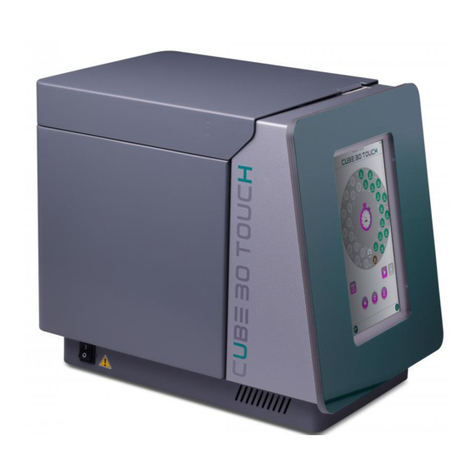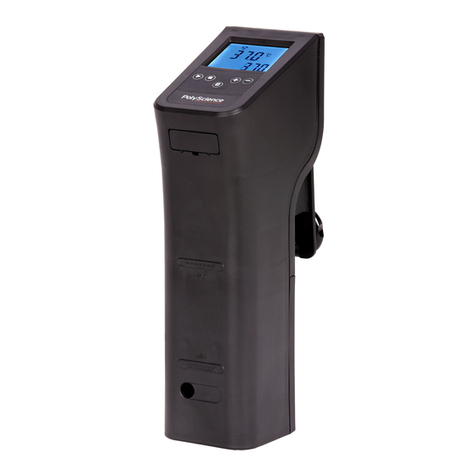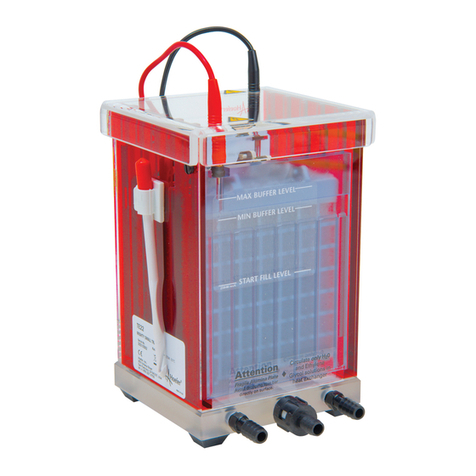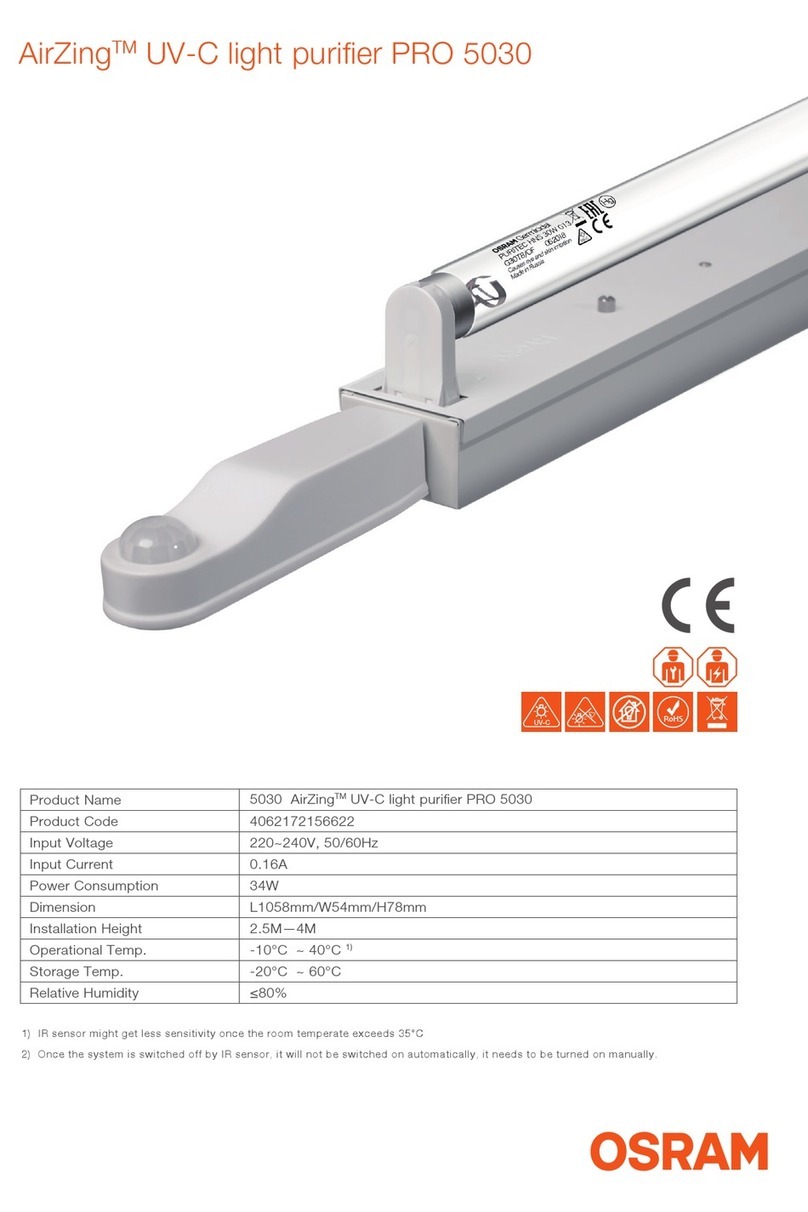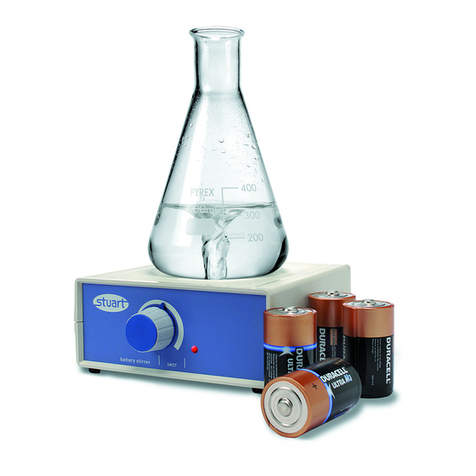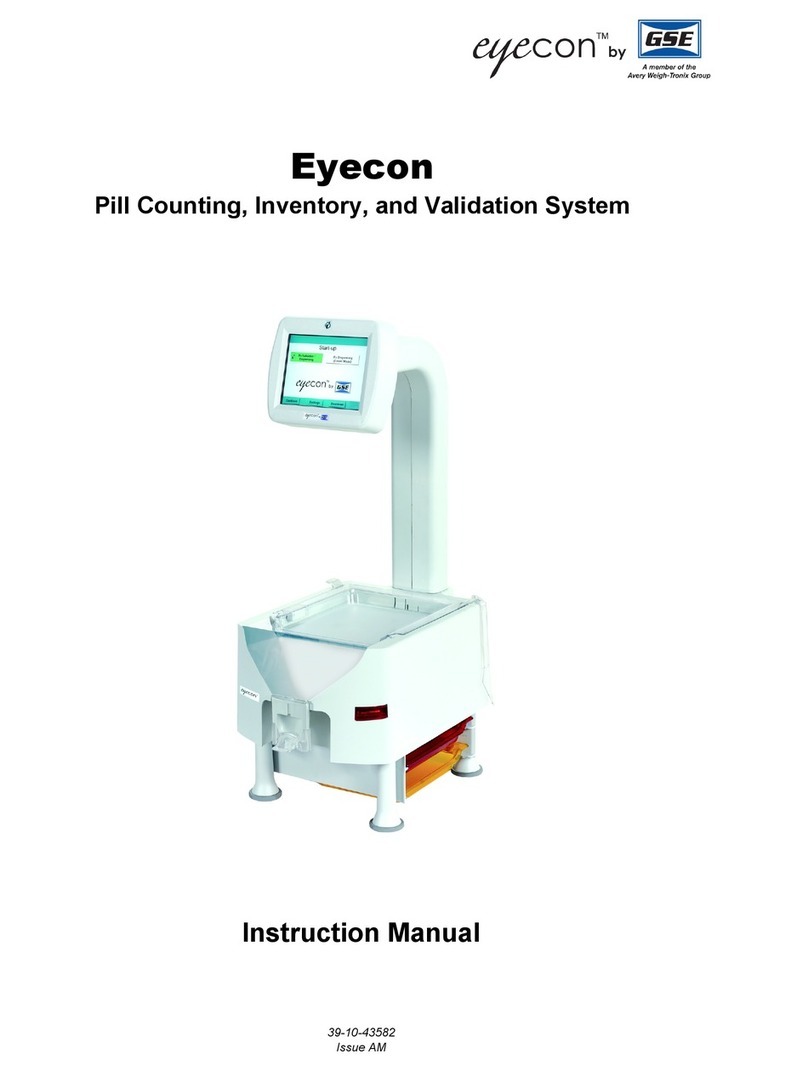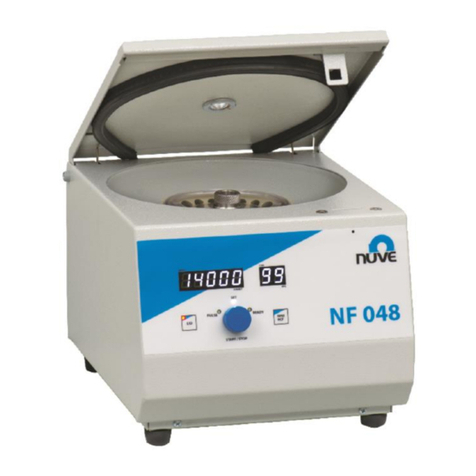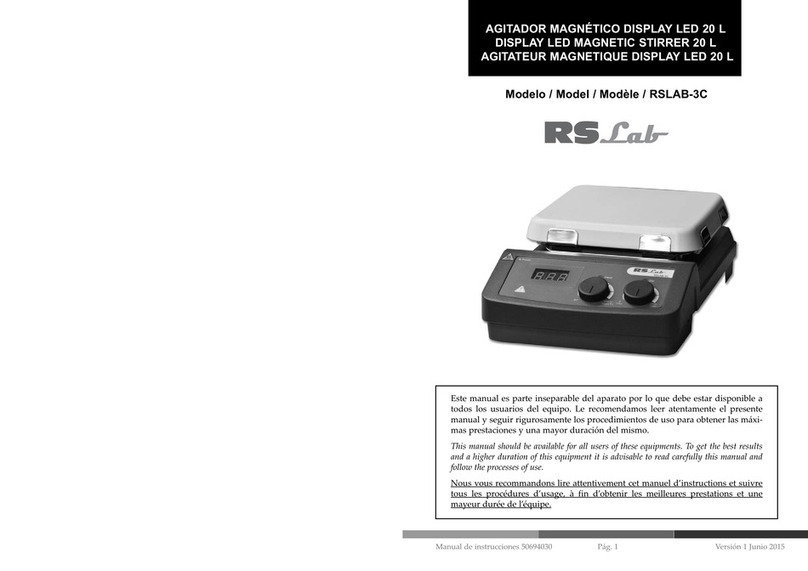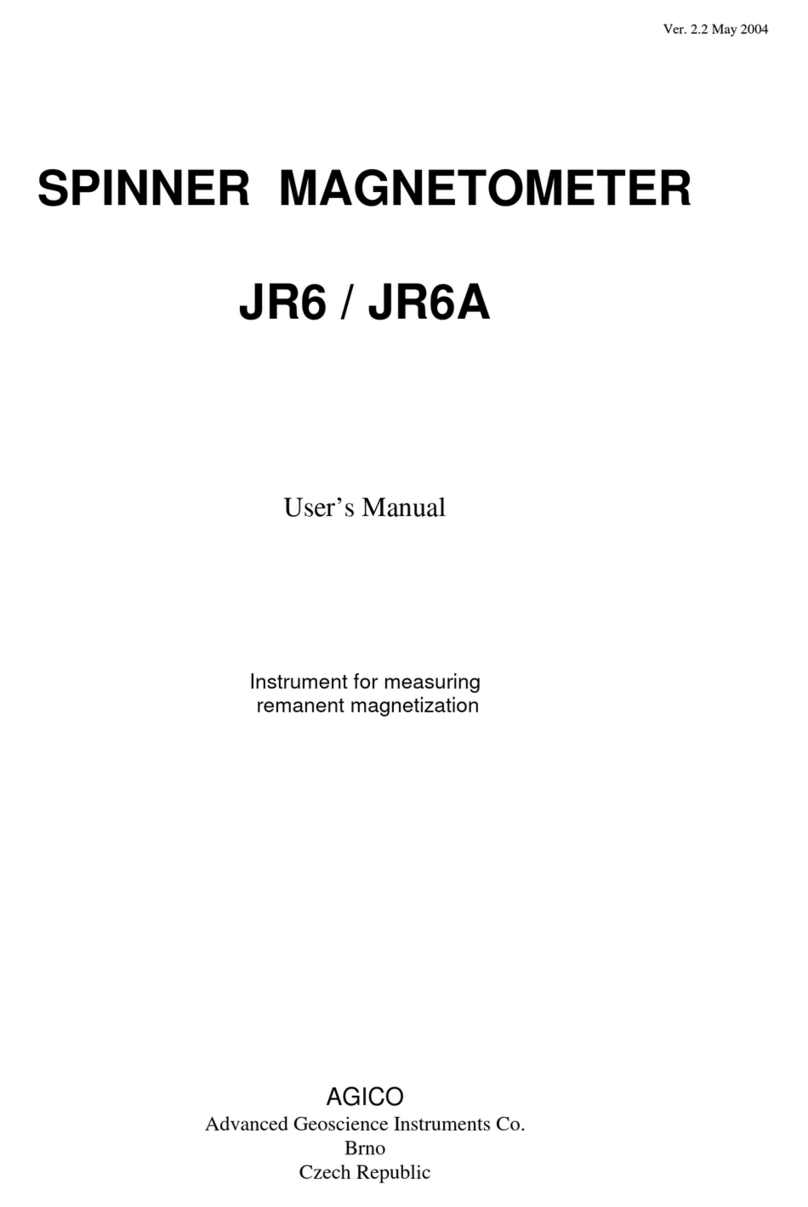Medem VGPS-evo V3 User manual

1
265
VGPS-evo V3.4
Installation Instructions
The VGPS-evo is a gas pressure proving system with ventilation interlock and optional CO2 detection.
The system will check the ventilation is switched on and running efore performing a down stream integrity
check ensuring gas tightness efore use. It will close the gas solenoid valve in the event of a ventilation
failure, gas leak detected during test, low incoming gas pressure or if the emergency stop/fire alarm is
activated.
It is designed for use primarily in kitchens.
.
Before commencing installation please familiarise yourself to the equipment y reading the comprehensive
installation instructions. If in dou t then please call 0161 233 0600. Out of hours please call 07894 684080 or
07843 355163.
It is a statutory requirement that this safety system is installed and commissioned
to the satisfaction of the manufacturer.
A commissioning certificate must e issued to the end user along with instructions for the operation of the
equipment.
As the Manufacturer Medem UK should commission this safety system whereupon a commissioning report
will e forwarded to the installing agent who should provide a copy to the end user.
At the point of our commissioning an individual serial num er will e attached to the system along with a 24
help line num er. Photos and all relevant information for the installation will then e stored on the Medem
site data ase to e accessed in the event of a call on the 24 hour help line. The warranty period for the
panel and sender unit will then e extended to Ten years.
• Gas Pressure proving.
• Ventilation interlock
• CO2 monitoring
• Over pressure alert
• 5 year warranty - 10 years when commissioned
VGPS-evo Features

2
265
System description
VGPS-evo
A Blind utton for displaying gas pressures on the LCD screen
B Blind utton for displaying the detectors on the LCD screen.
A B
Gas pressure proving and ventilation interlock system
The VGPS-evo system comprises of a mains powered main control panel, and low voltage pressure sender unit (plus fitting kit).
The pressure sender unit it mounted onto the gas valve (with the fitting kit) and transmits the gas pressure information ack to
the main panel in order to preform its integrity test.
The system includes ventilation interlock which will ensure that any mechanical ventilation connected (supply or extract) is
running efore the gas can e used, when installed with AD-MED-CO2 sensors (max 4) it will also monitor the atmosphere for
CO2.
Control Panel
The front of the panel has the following controls and indications:
Emergency stop utton.
System On/Off switch.
White Blind uttons A and B for engineer functions.
LED indications:
Power On - green………..A: lind utton for displaying gas pressures on the LCD screen
Gas On - red
Fans On - red
Alert – yellow…B: lind utton for displaying connected devices (detectors & temperature) on the LCD screen
LCD display:
For displaying system status during oth installation and normal use, also for displaying diagnostics
Pressure sender unit
Pressure sender unit transmits pressure information ack to the main panel in order for it to preform its integrity test. Its is not
optional and must e connected, the system will not wor without it.
It is mounted to the gas solenoid valve inlet and outlet test ports using 8mm OD copper pipe. Use the appropriate Medem fitting
kit to fit the control valve size (see page 10,11).
The pressure sender is connected to the control panel with screened low voltage two core ca le using the terminal marked A & B.
NOTE: This is low voltage and should be segregated from mains wiring.
Pressure Sender Unit
System On/Off ena les gas detection and use of
each service utton

3
265
Main features
VGPS-evo
Connections to panel: marked on oard
1. Live & Neutral 230 volts supply from 3amp switched fuse spur
2. 230 volts out to gas solenoid valve
3. Mains rated potential free relay which changes states on “Gas ON” for use with BMS
4. Earth connection terminals
5. Emergency Stop terminal SELV (requires a N/C contact).
6. Extract fan interlock for current monitor (CM2M-K) or PD switches.
7. Supply fan interlock for current monitor (CM2M-K) or PD switches.
8. 12 volt power for current monitor (CM2M-K)
9. Pressure sender unit SELV and comm’s oth through “A” & “B” terminals (2 wire) MUST BE FITTED.
10. Power connections for CO2 detectors.
11. Comms connections for CO2 detectors
12. Diagnostic Function: Displays inlet and outlet gas pressure at the gas valve.
13. Diagnostic Function: Lift valve - applies 230volts to power open the gas valve.
14. Diagnostic Function: “Fan commissioning” disa les ventilation interlock, for use during setup (timed function set y 20)
15. OPTA ON =
OPTB ON = No Gas isolation due to High CO2.
SPARE =
Rev Sen = Reverse sender inlet/outlet channel (only use with guidance from Medem support)
16. Fill time = “One’s of Seconds”
17. Prove time = “Minutes”
18. Sw=x2 = Multiply y 2 all the Fill and Prove timer settings.
Sw=x0.5 = Divide y 2 all the Fill and Prove timer settings.
CPI ACTV = Ena le CPI mode when using a valve with a CPI switch fitted.
SPARE = Fill in 15second increments.
19. Fan commissioning timer adjustment (default 24hrs)
20. Auto Stop setting (default disa led)
21. CO2 Alarm level adjustment (factory set to 2800ppm, as per HSE regulations)
22. Learn field device utton, press once only when all detectors are connected and powered.
23. Internal tone - ena le/disa le.
24. Optional BMS to indicate EM stop, Low & High Gas Alarm. (Not fitted y default - must e requested at point of order)
Power at 230
volts from a
3amp fused spur
1 2 3 4 6 7 8 9 10 11
12
16 17
18
19 20
21 22
5
23
24
13
14
15

4
265
VGPS-evo
16, 17. Fill and Prove
Gas Fill Time.
The Fill Time should e set such that there is sufficient time to fill an empty pipe work
system to full / normal pressure while ensuring a minimum escape of gas where a leak
exists.
(Factory default setting is 5 seconds).
Gas Prove Time. This should e set such that the smallest leak can e detected. This time
can e set up to a maximum of 9 minutes. Increasing this time effectively makes the
system more sensitive to gas leaks.
(Factory default setting is 1 minute).
FILL switch @ 1,2,3,4,5,6,7,8,9,0 = 1s, 2s, 3s, 4s, 5s, 6s, 7s, 8s, 9s, 10s,
PROVE switch @ 1,2,3,4,5,6,7,8,9,0 = 1m, 2m, 3m, 4m, 5m, 6m, 7m, 8m, 9m, 30s,
The prove time can e extended using FILL/PROVE MULTIPLIER, see No 18.
18. Fill/Prove multiplier
SW = X2 This dou les the fill & prove time.
SW = X0.5 This halves the fill and prove time test, please note the minimum prove time is 30
seconds which cant e reduced any lower.
Fan commissioning: This is for use during setup & commissioning to temporary disa le the ventilation interlock
this allows a gas engineer to work on the system even if the ventilation system hasn’t een completed.
Lift valve - applies 230volts to power open the gas valve. This allows you to manually pressurise upstream of
the valve.
Pressures - This will display oth the inlet and outlet gas pressure at the gas valve on the LCD screen. This
allows a visual indication of the gas tightness of the installation as well as an indication of the solenoid. The
same action can e preformed y pressing display “ lind utton A”.
12, 13, 14. Diagnostic Functions
System Settings
15. Option Switches
OPTA: ON = Hi CO2 isolation, OPTA OFF = Low CO2
OPTB: ON = No Gas isolation due to High CO2, OPTB OFF = EM Stop On
(If OPTA & OPTB are oth off then the BMS relay changes to oth EM-Stop and CO2 alerts states.)
Spare : Unused.
Reverse sender: Allows the inlet/outlet signals to e switched (use under guidance from edem)
12
13
14

5
265
System Settings
VGPS-evo
Press utton A - To display the gas pressures and view the set pressure proving set times.
Press utton B - To display the gas installed gas detectors 1-4.
Blind buttons - engineer features
BMS Relay PCB. For connection to a BMS to indicate, Em-stop Low & High Gas Alarm.
Max switching 48 volts 1 amp (not fitted y default)
Factory fit, must e fitted at point of order.
24. BMS Relay PCB
19, 20, 21. Option Headers
19.Fan timer setting. When using the “Fan Comm” utton (14) to allow commissioning of
the gas supply without interlocking the ventilation, the period of isolation can e
adjusted using these headers (default 24 hours)
20. The auto-stop timer function allows the system to e set to turn the gas off after a
pre-determined period of time. This is to help ensure the gas can not e left on and
availa le while unattended i.e. over night, or etween lessons (default is disa led)
21. CO2 high level alarm adjustment, this is factory set as per HSE regulations to
2800ppm. The system will report a low level alert at a reading of 2300ppm, if the high
level of 2800ppm is reached the system will isolate the gas supply
17 18
22 Learn Detectors
Learn Field devices
Any gas detectors connected to the system will require “learning”. First ensure all detectors are set to a unique
ID address using the selector switch on the detectors themselves (address’s 1 to 4 only). Having addressed each
detector press the learn field devices utton (19), the system will scan and store any connected detectors. To
verify that all detectors have
19 20
21
A B

6
265
Connections
Earth Connections not shown
230v Supply
3Amp Fused
EM Stop Buttons,
Thermal links
(Normally closed)
For multiple, connect
in series.
Pressure Sender unit
mounts on to the ody of the gas
valve
(Required)
Gas Solenoid
Medem
Gas detectors
Multiple,
connect in
parrallel
Two core low voltage connection
Volt free BMS Relay
Changes state on
“Gas ON/OFF”
(230v Rated)
VGPS-evo
Live feed through the
Medem CM2M-K channel current
Monitor
fans Fan speed
controls Fan live
Supply
Where using 3 phase fans
interlock on a single phase
6 core low voltage
+/- 12v Power
S1 = Supply Fan N/C contact
E1 = Extract Fan N/C contact
Fan Interloc Connections

7
265
VGPS-evo Remote stop uttons
To EM Stop connections in the
panel
Use terminals TB2 A & C Use terminals TB2 A & C
Remote stop uttons can e connected to the panel terminal
marked as “EM STOP” (num er 6 ).
The remote uttons must e wired as shown in order to provide
a “closed contact” for the control panel.
If thermal lin s are to be installed these should be wired
in series with the EM stop buttons
To EM Stop connections in the
panel
Indicator ar shows when
pressed
Normal EM-Stop Activated
Multiple Stop Buttons
Single Stop Buttons
Resetting (indicator bar)
The stop uttons supplied y Medem are of a “Push Glass, key resetta le” style, when activated a yellow indicator ar will
show and the unit will require resetting using the key provided.
Multiple stop uttons are wired in series.
If thermal links are to e installed these too should
e wired in series with the EM stop uttons
Use terminal TB2 A & C

8
265
Gas Detection
Gas Detectors
IMPORTANT - Gas Detectors should not e installed until all uilding, construction or painting work etc.. Is completed, as these
works can effect the sensitivity and longevity of the detectors.
Ensure that the protective cover la els (RED) are removed only
after the completion of all uilding work and the system has
een commissioned y the Medem engineer.
The la els are required to e removed for the detectors to
operate, ut removal efore the completion of works risks
contaminating the sensor element.
The system when installed with a AD-MED-CO2 sensor will monitor the atmosphere for CO2. Should the car on dioxide level rise
a ove 2300ppm the panel LCD will advise the staff to “increase ventilation”. Should the maximum allowed level of car on dioxide
(2800ppm) e reached the system will isolate the gas (after 45 seconds) and advise the staff to ventilate the room.
The detector types are:
• Car on Dioxide.
Also availa le are:
• Car on Monoxide.
• Com usti le gases (Methane, Propane).
Detector location will vary dependant on the individual characteristics of the target gas that is eing monitored for. See the gas
detectors own instructions for more guidance.
VGPS-evo Detector Information
Connection and addressing
+VE supply & Comm’s
From either the main panel or an
extender.
Detectors are wired in parallel and can e
connected to one another daisy chain
Address Selector
Each detector must e set to its own
address (1-4) and then “learnt” using
utton (19 see page 5)
Status LED
All current wiring regulations must e followed with reference to running low and mains voltage ca les together.
The maximum ca le length etween a detector and the control panel should not exceed 100 metres, if the distance etween
the main panel and the detectors is greater than 20metres a 1mm screened ca le must e used on the +VE, 0v terminals
Gas detectors, require a four core screened Belden type security ca le or 600v rated BMS ca le (max ca le length of
100meters.)
Pressure sender unit, remote emergency stops, require a two core screened ca le.
Warranty will e void if Fire Protection Ca le or ca le over 1mm dia. is used on the SELV side.

9
265
Detector Information
Detector location will vary dependant on the individual characteristics of the target gas that is eing monitored for.
The descriptions elow descri e the position for each detector after considering these characteristics.
For proper function care must e taken not to site a detector in a “dead space” or in the flow of any ventilation.
Natural Gas/Methane
Natural gas detectors should e mounted at high level on a wall approximately 150mm from the ceiling height and avoiding
corners and potential dead air areas.
Natural gas detectors should not e mounted elow the height of the top of a doorway for example. This is ecause as the gas
is slightly lighter than air it will rise filling the room from the ceiling down and will spill through the top of a door opening into the
next room. If the detectors are mounted elow this height then it will take longer the gas to reach the detector.
LPG /Propane
LPG gas is heavier than air so detectors need to e mounted at low level 100mm from the floor, consideration should e given
to any potential mopping or wet floor height.
Carbon Monoxide
Car on Monoxide is similarly weighted to air so detectors should e mounted etween 1 to 2 meters from the floor.
Carbon Dioxide
Car on Dioxide detectors should e installed so they monitor the general level of CO2 within the area. They should e mounted
a ove standing head height and etween 1m and 3m from the potential source. Care should e taken so they are not located
close to the edge of a canopy or in direct flow of the supply or extract ventilation.
For additional information or guidance on site specific requirements please don’t hesitate to contact us.
Each detector has its own Bi-Colour LED which is used to indicate the status of that detector.
Not Lit: No power/comm’s. These a four wire units and all connections are required, check the polarity of oth the
power and the comm’s (MA/MB) terminals are correct.
Flashing Green: Detector is warming up, the detectors will flash green on power up for 90 seconds while the sensor
elements sta ilize. The system will ignore any detectors while flashing.
Solid Green: Detector is powered and active. Note: The detectors will still require correctly addressing (using the address
selector pot) and learning y the system using utton (23, see page 5).
Flashing Red: Low level alarm. All detectors have oth a low and high level alarm, low level alarms serve as a warning
that an unsafe condition may e uilding and gives chance to intervene efore loss of gas service.
Solid Red High level alarm. An unsafe level of the target gas have een reached and the system will isolate the
gas supply. The cause of the alarm will require identifying and resolving efore the gas supply can e re-
esta lished.
After installation a simple ump test can e performed y using an appropriate level test gas in order to check operation. Full
testing and cali ration checking takes place during a Medem commissioning.
VGPS-evo
Detector Location
Detector Indications

10
265
VGPS-evo Sender & Valve connection
Incorrect
Ensure that the valve is correctly installed with regard to the direction of the flow of gas and that the Sender Unit is fitted the
correct way round. (Note: there is no flow “through” the pressure sender unit, it is purely reading the pressures either side of the
valve.
Correct
Pressur
e
Solenoid
Never mount the valve such that the Solenoid or Sender Unit are elow the horizontal.
Inlet Side/Upstream Outlet Side/Downstream
Direction of flow
Gas Solenoid and Sender Unit Mounting
Pressure sender unit

11
265
Fitting Kit
VGPS-evo
OUTLET PORT
Note: If this port is lanked off,
use port on ase of valve.
WALL MOUNTING STRAP
NOTES:
Solenoid coil of the valve should never e mounted elow the horizontal.
Pressure sender unit should never e mounted upside down (to protect from water ingress)
Approx 400mm length
INLET PORT & OUTLET PORT
Note: These ports could e
side y side
Mounting details - Fitting it
PRESSURE SENDER UNIT
INLET PORT
Fitting it - Contents

12
265
Warranty
VGPS-evo
Medem (UK) Limited
Project House
19 Dallimore Road
Manchester
M23 9NX
Tel: (0) 161 233 0600
Fax: (0) 161 233 0601
We : www.medem.co.uk
E-mail: sales@medem.co.uk
Medem UK Warranty
Terms & Conditions
1. The warranty is a parts warranty and Medem UK Ltd will not cover or accept any la our or
other expenses that may e incurred in the process of changing faulty product.
2. All panels and sender units are covered y a five year warranty.
3. Gas detector units and other remote detectors carry a two year warranty. Installation of the
detectors should not e undertaken until all uilding and construction work is completed.
4. Gas solenoid valves carry the original manufacturers warranty, though as the supplier
Medem UK will exchange faulty valves for return to the manufacturer.
5. Where a Medem UK engineer (or another company appointed y Medem UK) commission
and installed system then that system will carry a ten year warranty. This applies to the
main panel and the sender unit. At the time of commissioning a security la el with a serial
num er will e attached to the main panel ox. photographs and a comprehensive record
of the installation will e held y Medem UK.
6. Where a warranty claim is made then, where appropriate, a written order to attend site
must e provided to Medem UK A cost for la our and travel to site will e prepared as a
quote. The cost must e included in the order.
7. Where it is found that the installation and/or the quality of workmanship has contri uted to
or wholly caused the failure of the product then we reserve the right to charge the whole or
a proportion of the cost of the faulty item.

13
265
It is essential that the installation is carried out in the order given
elow to ensure the correct operation of the system.
First read the system description sheet efore following the
instructions elow
1, Connect the Control valve twin & earth to the marked terminals.
2, Connect BM , beacons, sounders etc to the relay outputs.
3, Connect the pressure sender unit to the marked terminals.
4, Connect any additional EM stop buttons and thermal links in series to the terminals marked “em stop”.
5, Each detector has a rotary address switch and each switch should be set to a different number or letter starting with “1”.
Then connect the gas detectors to terminals marked “detectors” on the panel. Detectors can be wired “Daisy chain”.
6, Connect the 3 amp fused spur 240 volt supply to marked terminals.
7, At this point check that the sender unit has been fitted to the control valve and that gas is available.
8, Once power is connected to the panel the detectors will flash the green LEDs for 90 seconds after which the LEDs will be on
continuously.
9, Press the “learn field button” this is on the main circuit board on the right hand side, just over half way up the board. Pressing
this once allows the panel to learn how many detectors are fitted.
10, Press and keep pressed the “display detectors” button whilst checking on the LCD display that all the detectors have been
recognised by the panel. A recognised detector will appear as “CO2” in the display. Count the number of “seen” Detectors on
screen and ensure total is the same as the number of detectors installed. NM means that address is not monitored.
11, At this point turn the on/off switch to the on position and the panel will test to ensure gas tightness and provided there are no
leaks the panel will allow gas and the gas on LED will light. hould the gas test fail then press the pressure button to see
the gas pressure in mbars on both sides of the valve. Thus you can see the pressure drop downstream provided the valve is
closed.
12, Check that the panel can see the smallest allowable pressure drop if it does not then increase the proving time by adjusting
the blue rotary dials on the circuit board.
13, Fan interlocking is done using the terminals 1(supply air) and E1 (extract air), these terminals require a volt free normally closed
contact. Interlock can be done using airflow switches or current monitoring (CM2M-K). Current montitoring has shown to be the
most reliable method of interlocking ventilation.
Checklist
VGPS-evo
Please do not hesitate to call for advice on the
following numbers:
0161 233 0600 office hours
Or out of hours call:
Notes.
It is recommended that all systems are commissioned aer installaon by Medem U . This will extend the warranty period from 5
years to 10 years and ensure the system is working as designed.
Please see warranty condions that came with the main panel

14
265
messages
VGPS-evo
Test fail chec all appliances:
The system has found an escape of gas, the most common cause is an open appliance. Check all appliances are off and restart
the pressure test. If the system still reports test fail then a leak will e on the pipe work. Using “Blind utton A” (see page 2) you
can view the gas pressures at the valve, the outlet pressure must remain at least 90% of the value of the inlet pressure or a leak
will e declared.
Error from valve sender unit
System is not receiving data from the sender unit. The pressure sender is a required part of the system and cannot e “linked
out”. Verify the sender is correctly wired and that you have a green flashing LED on the sender unit.
Detector fault XX
The system elieves it has lost connection to a detector on address XX, verify detector addresses and press the “learn
utton” (23). Verify all connected detectors are eing registered y pressing “ lind utton B” (see page 2). If you have no
detectors connected to the system pressing the learn utton will clear the error message.
Supply and/or Extract fans not running.
The system can monitor the fan status via a current monitor or air pressure switches. These provide a closed contact to
terminals S1 and E1, it is a requirement when using fan interlocking that the fans e running (and therefore the S1 and E1
receiving a closed contact) efore the system can egin a gas pressure test. If at any point the fans stop running (opening the S1
or E1 contact) the system will isolate the gas and report fans not running. Check that the fans are not only switched on, ut
actually running and moving air.
Low incoming gas pressure.
The system requires a minimum of 13 mBar of pressure at the inlet side of the gas valve, this is to ensure a correct strength
flame. If at any time the incoming pressure drops elow 13mBar for more than 10 seconds the system will isolate the gas and
report “low incoming gas pressure”
Note: if this occurs during installation check the sender unit direction of flow, if the sender is installed ackwards the system will
elieve the “outlet” to e the “inlet” and therefore see an open end as eing low incoming gas pressure.
Emergency stop button pressed.
The system has an panel mounted emergency stop and connection inside for remote uttons. First check the panel utton (once
pressed some require resetting y twisting and releasing). Clear the message y turning the main system switch off and then
ack on, if the message remains check any remote uttons and their connections. The terminal for the remote uttons requires
a volt free normally closed contact, ensure all remote stop uttons, thermal links any another connected systems (BMS/Fire
panels) are reset and the contacts are closed.
In the event of any alert the system will always give a reason on screen as to the cause.
Common messages you may receive are shown elow with further explanation.
If you require any help or if anything is unclear then please contact technical support on 0161 233 0600
Table of contents
Other Medem Laboratory Equipment manuals
